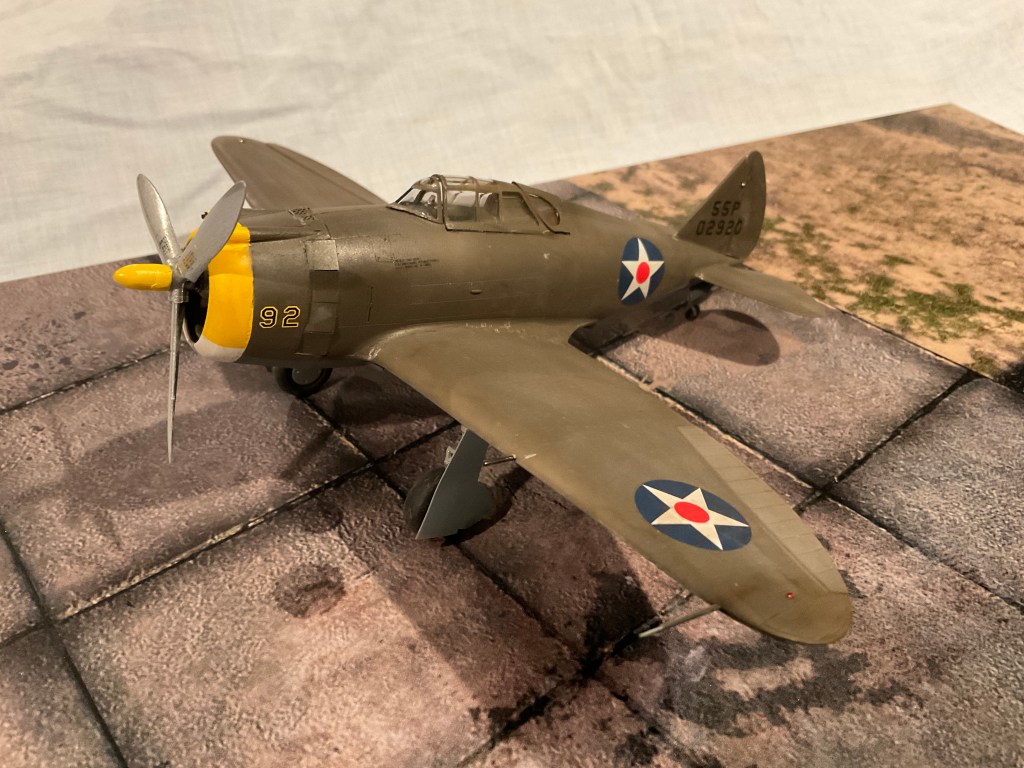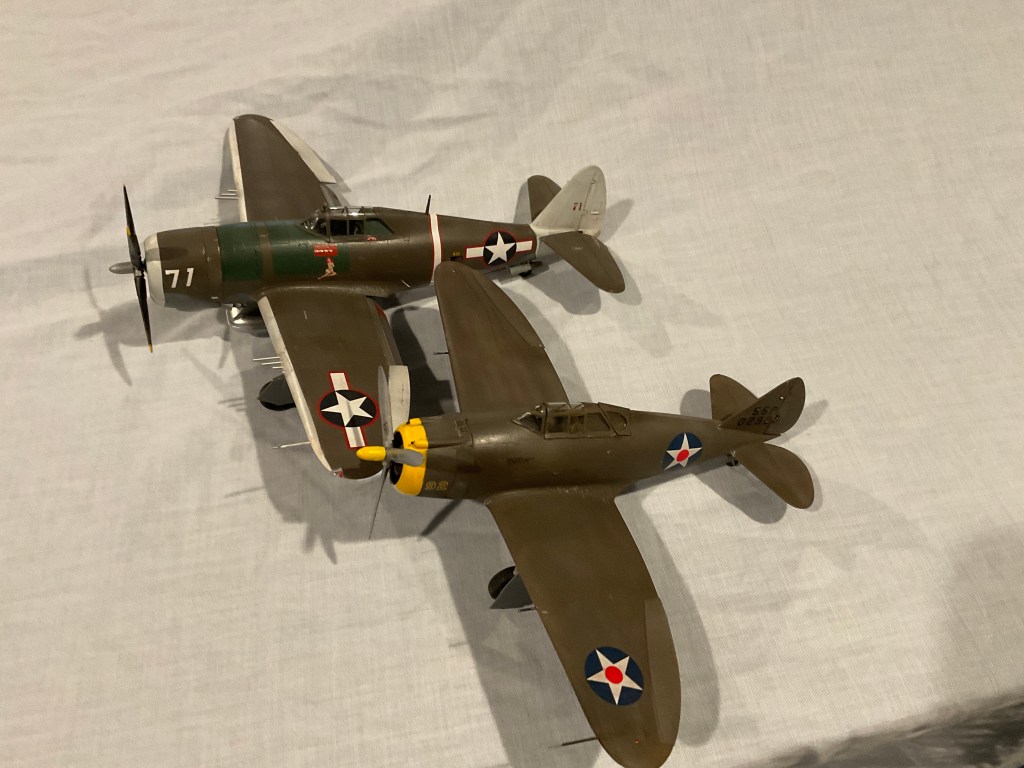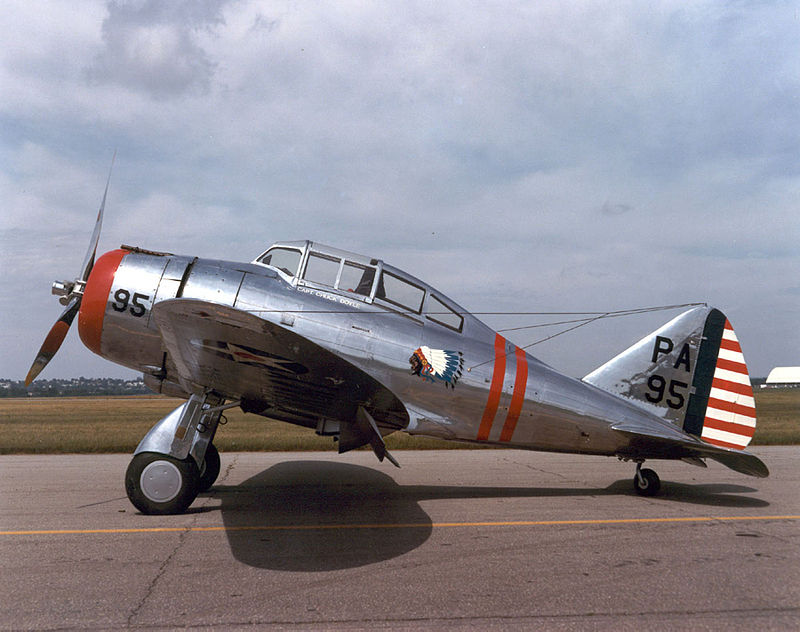
Among the less known types of the USAAF in World War II. Let’s take a look at an aircraft that was important as a development, if not for actual combat.
I’ve seen the Lancer referred to as the “Baby ‘Bolt”, which seems fitting in several ways. Its not hard to see the resemblance to Republic’s later and bigger P-47 Thunderbolt.

The Thunderbolt was the ultimate expression of Alexander Kartveli’s design that first flew in June, 1933 as a three seat amphibian known as the Seversky SEV-3. This basic design became a two-place fighter, the SEV-2XP and a trainer produced for the AAC as the BT-9. None of these aircraft were mass produced and all were considered under-powered. They were also all fixed gear types, but the shape was aerodynamically clean and structurally modern.

The Air Corp announced a flying competition for a new fighter in June 1935. Seversky thought the SEV-2XP would do well; fortunately, it was severely damaged in accident beforehand. Kartveli had seen the sleek, single seat, retractable gear Hawk 75 they would be competing against and knew something had to be changed. After getting a delay to August for the competition he re-worked the aircraft into the “SEV-1XP”, a single seater with retractable landing gear.
The landing gear was an interesting, first generation sort of attempt. It simply folded straight back into the wing, like a B-17. But the much smaller wing meant a large fairing was needed to smooth the airflow. When the gear was down this left a huge scoop hanging down from the wing. The arrangement was heavy and draggy, especially with the gear down.
Still, the design was modern and promising, and ordered as the P-35. I’ve mentioned before how Seversky and Curtiss would compete over the next couple years as they changed engines and tweaked details on their new fighters.

Seversky also built several racers and civil aircraft from this basic pattern, including a personal aircraft for James Doolittle. But when they put an improved R-1830 engine on it, the Air Corp took a pass. They felt Curtiss had clearly pulled ahead in the design competition and a few more horsepower wasn’t going to help the P-35.
In 1939, Seversky did convince the Air Corp to convert the last production P-35 into something “new”. More modern landing gear, that folded inwards into the wing and a two-speed supercharger for the engine became the XP-41. Performance was much improved, but Kartveli’s new airplane remained a one-off, it was surpassed by another Alexander Kartveli design. While conversion work was starting on the XP-41, Kartveli also had a team working with Boeing on adapting the high altitude turbo-charging used on the Flying Fortress for a fighter. This was an enlarged version of the airframe he’d been working with for years. It had everything the XP-41 had, plus the turbo-charger and a more modern oxygen system. Some of what all happened here gets a little confusing to me, because there was also a development mule known the “AP-4”, that tested features but I don’t believe was ever actually considered anything other than a test aircraft. But it does lead there being no “XP-43”. The new design was ordered by the Air Corp as 13 service test “YP-43 Lancers”.

We’ve made it a long way into this post before the P-43 is first really brought up! The Air Corp was actually pretty happy with their new aircraft. It delivered 1200 horsepower, and with all that boost it could maintain a speed of 350 mph up over 35k feet. Very impressive for that time. More about the Lancer in a moment, but the rush of developments continued. Before the YP-43 even flew, a new version was proposed. Pratt and Whitney was testing an R-2180 (Hornet) engine. Just a little more size and power, which led to a proposed XP-44 Rocket derived from the AP-4 airframe.
This was getting to be a big and expensive aircraft! That was making some people in Washington nervous. So Republic (Seversky changed its name in 1939… one of those details we just blew right past…) proposed a new lightweight fighter using the Allison V1710 engine. This was considered a good idea and was ordered as the XP-47. Now that doesn’t sound right…
People were paying attention to air combat over Europe. Lightweight maybe wasn’t the way to go? It seemed speed and altitude mattered, as did firepower, pilot armor, self sealing fuel tanks, modern radios and navigation equipment. The XP-47 became the XP-47A with nothing built. Kartveli abandoned the light idea and went the other way. Getting the biggest engine he could, the new R-2800, and pairing it with all his experience with turbo-charging he created a monster to meet every stated need. Work was finally started on the XP-47B, which sounds more like the plane we are all familiar with.


Going back to September 1940, the first YP-43 Lancers were being delivered. They performed well enough, but it was recognized it was lacking compared European combat types. Their firepower was a little light with 2 x .30, one in each wing and 2 x .50 in the nose. They lacked pilot armor, that could be fixed but it would incur a weight penalty. And a “wet wing”, that meant fuel was stored in the wing structure itself for improved capacity. But that was sort of the opposite of a self sealing tank, that’s more of an extra vulnerable leaky tank.
Republic was designing aircraft the Air Corp was sure they’d want in the near future, so the Lancer was ordered into production as the P-43. This would keep Republic in business, and help them ramp up capacity for more serious orders to follow. After 54 P-43 were built, production switched to the P-43A which changed the .30s in the wings to .50s. P-43A was also supposed to add pilot armor, but apparently most were delivered without. All told, 272 P-43s of all three sub-types were built. These were mostly assigned to US based air defense squadrons. The particular aircraft shown here was assigned to the 55th Pursuit Group in Portland, Oregon, early 1942. In time, that would be a P-38 group and that’s how they finally deployed to England. But in late 1941 – 1942 the USAAC/USAAF was growing explosively, and there was often not enough of anything to go around. So the P-43s filled out stateside fighter groups. This is what “Wild Bill Kelso” should have been flying in 1941!


An unknown number, less than 100, were lend-leased to China. Pilots loved its high altitude performance, structural ruggedness and the durability of the radial engine. The pilots of the AVG were very excited on seeing the type and asked General Claire Chennault to get them some. He declined because of its lack of armor and self sealing tanks. Col Robert Lee Scott, a transport pilot at the time (later commander of the 23rd Fighter Group and author of “God is my Co-Pilot”) took a P-43 up to 44000 feet and photographed Mt Everest from above.
But the fuel tanks really proved to be a problem. Actual accounts of their usage in China are hard to come by, but one pilot, Major Zheng Shaoyu, was liaison officer with the Flying Tigers and had just taken delivery of a new P-43 when its leaky fuel system was ignited by the hot turbo charger. The explosion killed him. Several P-43s were abandoned by the Chinese at American bases (this was how Robert Scott got the plane he flew). The Flying Tigers, and later 23rd Fighter Group, used some of these cast-offs as high altitude photo planes until 1944.
The P-43 was flown enough by the Chinese for the Japanese to have an opinion of the type. It was noted as very fast up high and with a good rate of roll. But it was less maneuverable than a P-40 down low, and ignited easily when hit. If the Japanese thought that was notable its saying something!


Meanwhile, back stateside… 150 P-43s were converted into photo-recon types, and redesignated as P-43B. They remained fully armed. Eight of these aircraft were sent to Australia and flew with RAAF No. 1 Photo Reconnaissance Unit for about a year until they could be replaced with F-5 Lightnings.
By the end of 1942 all P-43s were reclassified as “RP-43”, with the “R” for Restricted [from combat operations].

This is the Dora Wings kit. It is the first I’ve built from that Ukrainian company. BTW, several of these Ukrainian companies have done a remarkable job of remaining open for business. Their website proclaims profits are being sent to the Ukrainian Army. And although the company’s principal is currently deployed with the Army, the company is still doing business.
The product itself is clearly limited run, maybe even more so than the Modelsvit kits I built previously. Plastic is very soft, and every part needs some clean-up and minor reshaping before things will fit together right. I find this less intimidating than I did a few months ago, but I obviously still have a lot to learn before I can get these type kits looking as good as I would like. The heavy reliance on photo-etch is particularly problematic for me, four parts on the cowling (including cowl flaps) were the biggest struggle. I simplified the engine and landing gear (which is a good way of saying I left parts out), mostly things that are difficult or impossible to see. Overall I’m happy with the result, but hope to do better in the future. And Dora Wings has, without a doubt, the most appealing catalogue of any of these small companies, so I will do more of them in the future.
I also used the Wolfpack color photo-etch update set that added some nice detail to the cockpit. I got it mainly for the pilot’s seat, which looked much better than the kit part. The seat belts and instrument panel were also improvements, but maybe not as highly visible.



Pingback: Republic P-43A Lancer – My Forgotten Hobby V
A very thorough account of an interesting family tree. Is there any reason that the US insignia is only ever used on one wing? I think that the US is the only country ever to do it. I’m pretty sure that I’ve never seen ny othe country with this system.
That is an interesting question! There was a period, early in the War, when two were used (most of 1942?, I’d need to check references). But I think the idea was not to be symmetrical. They didn’t want to give any enemy an aiming point. Similar to how Polish insignia was always off center (so directly in between the wing insignia was NOT the pilot’s seat!) obviously most militaries considered this a silly and unlikely occurrence to worry about!
I don’t know, but the Pittsburgh Steelers only have the logo on one side of the helmet.
Makes it harder to hit them in the face?
Non sequitur aside it is nice to see a plane with some history and a lineage. So often it seems so many of the designs in the 30’s came from nowhere and most went nowhere. The fortunate few, like the Spitfire, the Mosquito, the P-38 went on to great success, but it is also nice that a few like the Mustang and the Thunderbolt had some history and development before their most famous realizations.
Yeah I think the Thunderbolt has one of the more convoluted lineages. Although Alexander Kartveli oversaw all of it.